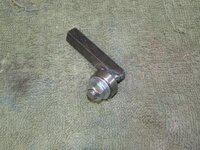effective center
just a point to remember. the "center " is the effective center, not necessarily vertical center. Having spent 30+ years in this field i have many times placed the tool above center with a negative rake on the tip. another trick is to run in reverse and put your tool upside down. this helps many times with chip removal and allows chips to fall down out of the way. also helps eliminate chatter at times. in that case "below center" would actually be above, spatially speaking. Wasn't aware that there were that many guys on here with metal lathes. If anyone needs help in this field, i would be glad to assist. that is one field where i do consider myself an "expert" not a beginner as in pen turning. Engineering, gearing, tooling, fixtureing etc. are all right in my wheel house. Just drop me a pm and i will be more than happy to assist. .



